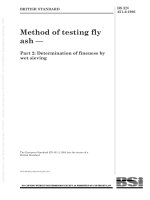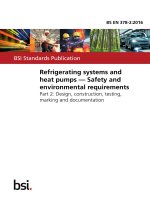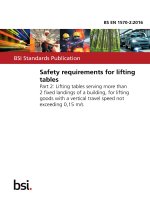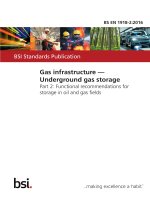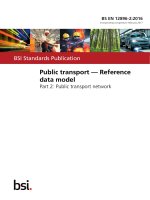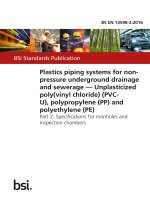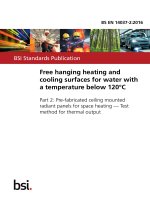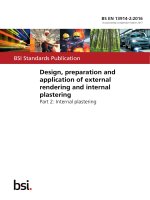Bsi bs en 61340 2 3 2016
Bạn đang xem bản rút gọn của tài liệu. Xem và tải ngay bản đầy đủ của tài liệu tại đây (2.56 MB, 34 trang )
BS EN 61340-2-3:2016
BSI Standards Publication
Electrostatics
Part 2-3: Methods of test for determining
the resistance and resistivity of solid
materials used to avoid electrostatic
charge accumulation
BRITISH STANDARD
BS EN 61340-2-3:2016
National foreword
This British Standard is the UK implementation of EN 61340-2-3:2016. It is
identical to IEC 61340-2-3:2016. It supersedes BS EN 61340-2-3:2000 which
will be withdrawn on 28 July 2019.
The UK participation in its preparation was entrusted to Technical
Committee GEL/101, Electrostatics.
A list of organizations represented on this committee can be obtained on
request to its secretary.
This publication does not purport to include all the necessary provisions of
a contract. Users are responsible for its correct application.
© The British Standards Institution 2017.
Published by BSI Standards Limited 2017
ISBN 978 0 580 87830 5
ICS 17.220.99; 29.020
Compliance with a British Standard cannot confer immunity from
legal obligations.
This British Standard was published under the authority of the
Standards Policy and Strategy Committee on 31 January 2017.
Amendments/corrigenda issued since publication
Date
Text affected
BS EN 61340-2-3:2016
EUROPEAN STANDARD
EN 61340-2-3
NORME EUROPÉENNE
EUROPÄISCHE NORM
October 2016
ICS 17.220.99; 29.020
Supersedes EN 61340-2-3:2000
English Version
Electrostatics - Part 2-3: Methods of test for determining the
resistance and resistivity of solid materials used to avoid
electrostatic charge accumulation
(IEC 61340-2-3:2016)
Électrostatique - Partie 2-3: Méthodes d'essais pour la
détermination de la résistance et de la résistivité des
matériaux solides destinés à éviter les charges
électrostatiques
(IEC 61340-2-3:2016)
Elektrostatik - Teil 2-3: Prüfverfahren zur Bestimmung des
Widerstandes und des spezifischen Widerstandes von
festen Werkstoffen, die zur Vermeidung elektrostatischer
Aufladung verwendet werden
(IEC 61340-2-3:2016)
This European Standard was approved by CENELEC on 2016-07-28. CENELEC members are bound to comply with the CEN/CENELEC
Internal Regulations which stipulate the conditions for giving this European Standard the status of a national standard without any alteration.
Up-to-date lists and bibliographical references concerning such national standards may be obtained on application to the CEN-CENELEC
Management Centre or to any CENELEC member.
This European Standard exists in three official versions (English, French, German). A version in any other language made by translation
under the responsibility of a CENELEC member into its own language and notified to the CEN-CENELEC Management Centre has the
same status as the official versions.
CENELEC members are the national electrotechnical committees of Austria, Belgium, Bulgaria, Croatia, Cyprus, the Czech Republic,
Denmark, Estonia, Finland, Former Yugoslav Republic of Macedonia, France, Germany, Greece, Hungary, Iceland, Ireland, Italy, Latvia,
Lithuania, Luxembourg, Malta, the Netherlands, Norway, Poland, Portugal, Romania, Slovakia, Slovenia, Spain, Sweden, Switzerland,
Turkey and the United Kingdom.
European Committee for Electrotechnical Standardization
Comité Européen de Normalisation Electrotechnique
Europäisches Komitee für Elektrotechnische Normung
CEN-CENELEC Management Centre: Avenue Marnix 17, B-1000 Brussels
© 2016 CENELEC All rights of exploitation in any form and by any means reserved worldwide for CENELEC Members.
Ref. No. EN 61340-2-3:2016 E
BS EN 61340-2-3:2016
EN 61340-2-3:2016
European foreword
The text of document 101/470/CDV, future edition 2 of IEC 61340-2-3, prepared by
IEC/TC 101 "Electrostatics" was submitted to the IEC-CENELEC parallel vote and approved by
CENELEC as EN 61340-2-3:2016.
The following dates are fixed:
•
latest date by which the document has to be
implemented at national level by
publication of an identical national
standard or by endorsement
(dop)
2017-04-28
•
latest date by which the national
standards conflicting with the
document have to be withdrawn
(dow)
2019-07-28
This document supersedes EN 61340-2-3:2000.
Attention is drawn to the possibility that some of the elements of this document may be the subject of
patent rights. CENELEC [and/or CEN] shall not be held responsible for identifying any or all such
patent rights.
Endorsement notice
The text of the International Standard IEC 61340-2-3:2016 was approved by CENELEC as a
European Standard without any modification.
2
BS EN 61340-2-3:2016
EN 61340-2-3:2016
Annex ZA
(normative)
Normative references to international publications
with their corresponding European publications
The following documents, in whole or in part, are normatively referenced in this document and are
indispensable for its application. For dated references, only the edition cited applies. For undated
references, the latest edition of the referenced document (including any amendments) applies.
NOTE 1 When an International Publication has been modified by common modifications, indicated by (mod), the relevant
EN/HD applies.
NOTE 2 Up-to-date information on the latest versions of the European Standards listed in this annex is available here:
www.cenelec.eu
Publication
Year
Title
EN/HD
Year
IEC 62631-3-1
-
Dielectric and resistive properties of solid EN 62631-3-1
insulating materials Part 3-1 Determination of resistive
properties (DC Methods) - Volume
resistance and volume resistivity, general
method
-
IEC 62631-3-2
-
Dielectric and resistive properties of solid
insulating materials Part 3-2 Determination of resistive
properties (DC Methods) - Surface
resistance and surface resistivity
EN 62631-3-2
-
IEC 62631-3-3
-
Dielectric and resistive properties of solid
insulating materials Part 3-3: Determination of resistive
properties (DC methods) - Insulation
resistance
EN 62631-3-3
-
ISO 1853
-
Conducting and dissipative rubbers,
vulcanized or thermoplastic Measurement of resistivity
-
-
ISO 2951
-
Rubber, vulcanized or thermoplastic Determination of insulation resistance
-
-
ISO 3915
-
Plastics - Measurement of resistivity of
conductive plastics
EN ISO 3915
-
ISO 7619-1
-
Rubber, vulcanized or thermoplastic Determination of indentation hardness Part-1: Durometer method (Shore
hardness)
-
-
3
–2–
BS EN 61340-2-3:2016
IEC 61340-2-3:2016 © IEC 2016
CONTENTS
FOREWORD ........................................................................................................................4
INTRODUCTION ..................................................................................................................6
1
Scope ...........................................................................................................................7
2
Normative references ....................................................................................................7
3
Terms and definitions ....................................................................................................7
4
Conditioning and test environment .................................................................................9
5
Selection of test method ................................................................................................9
6
Resistance measurements for solid conductive materials ............................................. 10
7
Resistance measurements for solid insulating materials ............................................... 10
8
Resistance measurements for planar electrostatic dissipative materials (used to
avoid electrostatic charge accumulation) ...................................................................... 10
8.1
Instrumentation ................................................................................................... 10
8.1.1
General ...................................................................................................... 10
8.1.2
Instrumentation for laboratory evaluation .................................................... 10
8.1.3
Instrumentation for acceptance testing ....................................................... 10
8.1.4
Instrumentation for compliance verification (periodic testing) ...................... 11
8.2
Electrode assemblies .......................................................................................... 11
8.2.1
General ...................................................................................................... 11
8.2.2
Assembly for the measurement of surface resistance.................................. 11
8.2.3
Assembly for the measurement of volume resistance .................................. 12
8.2.4
Assembly for the measurement of resistance to ground/groundable
point and point-to-point resistance ............................................................... 12
8.2.5
Test support ............................................................................................... 13
8.3
Sample preparation and handling ........................................................................ 13
8.4
Test procedures .................................................................................................. 14
8.4.1
Surface resistance measurements .............................................................. 14
8.4.2
Volume resistance measurements .............................................................. 14
8.4.3
Resistance to groundable point measurements ........................................... 15
8.4.4
Point-to-point resistance measurements ..................................................... 16
9
Conversion to resistivity values .................................................................................... 17
9.1
Surface resistivity ρ s ........................................................................................... 17
9.2
Volume resistivity ρ v ........................................................................................... 17
10 Resistance measurements for non-planar materials and products with small structures
................................................................................................................................... 18
10.1 General considerations ....................................................................................... 18
10.2 Equipment .......................................................................................................... 18
10.2.1
Probe ......................................................................................................... 18
10.2.2
Sample support surface ............................................................................. 20
10.2.3
Resistance measurement apparatus ........................................................... 20
10.2.4
Test leads .................................................................................................. 21
10.3 Test procedure .................................................................................................... 22
11 Repeatability and reproducibility .................................................................................. 22
12
Test report .................................................................................................................. 23
Annex A (normative) System verification ............................................................................ 25
A.1
System verification for surface resistance measurements .................................... 25
BS EN 61340-2-3:2016
IEC 61340-2-3:2016 © IEC 2016
–
–3–
Fixture and procedure for lower resistance range ....................................... 25
Fixture and procedure for upper resistance range and determination of
electrification period ..................................................................................... 26
A.2
System verification for volume resistance measurements .................................... 27
A.2.1
Fixture and procedure for lower resistance range ....................................... 27
A.2.2
Fixture and procedure for upper resistance range and determination of
electrification period ..................................................................................... 27
A.3
System verification for resistance measurements for non-planar materials
and products with small structures ...................................................................... 27
A.3.1
Verification fixtures .................................................................................... 27
A.3.2
Verification procedure ................................................................................ 28
A.1.1
A.1.2
Figure 1 – Example of an assembly for the measurement of surface and volume
resistance........................................................................................................................... 12
Figure 2 – Example of an assembly for the measurement of resistance to
ground/groundable point and point-to-point resistance ........................................................ 13
Figure 3 – Basic connections of the electrodes for surface resistance measurements ......... 14
Figure 4 – Basic connections of the electrodes for volume resistance measurements ......... 15
Figure 5 – Principle of resistance to groundable point measurements .................................. 16
Figure 6 – Principle of point-to-point measurements ............................................................ 17
Figure 7 – Configuration for the conversion to surface or volume resistivity ......................... 18
Figure 8 – Two-point probe configuration ............................................................................ 20
Figure 9 – Probe to instrumentation connection ................................................................... 21
Figure 10 – Spring compression for measurement ............................................................... 22
Figure A.1 – Lower resistance range verification fixture for surface resistance
measurements .................................................................................................................... 25
Figure A.2 – Upper resistance range verification fixture for surface resistance
measurements .................................................................................................................... 26
Figure A.3 – Resistance verification fixture ......................................................................... 28
Table 1 – Material for two-point probe ................................................................................. 19
–4–
BS EN 61340-2-3:2016
IEC 61340-2-3:2016 © IEC 2016
INTERNATIONAL ELECTROTECHNICAL COMMISSION
____________
ELECTROSTATICS –
Part 2-3: Methods of test for determining the resistance
and resistivity of solid materials used
to avoid electrostatic charge accumulation
FOREWORD
1) The International Electrotechnical Commission (IEC) is a worldwide organization for standardization comprising
all national electrotechnical committees (IEC National Committees). The object of IEC is to promote
international co-operation on all questions concerning standardization in the electrical and electronic fields. To
this end and in addition to other activities, IEC publishes International Standards, Technical Specifications,
Technical Reports, Publicly Available Specifications (PAS) and Guides (hereafter referred to as “IEC
Publication(s)”). Their preparation is entrusted to technical committees; any IEC National Committee interested
in the subject dealt with may participate in this preparatory work. International, governmental and nongovernmental organizations liaising with the IEC also participate in this preparation. IEC collaborates closely
with the International Organization for Standardization (ISO) in accordance with conditions determined by
agreement between the two organizations.
2) The formal decisions or agreements of IEC on technical matters express, as nearly as possible, an
international consensus of opinion on the relevant subjects since each technical committee has representation
from all interested IEC National Committees.
3) IEC Publications have the form of recommendations for international use and are accepted by IEC National
Committees in that sense. While all reasonable efforts are made to ensure that the technical content of IEC
Publications is accurate, IEC cannot be held responsible for the way in which they are used or for any
misinterpretation by any end user.
4) In order to promote international uniformity, IEC National Committees undertake to apply IEC Publications
transparently to the maximum extent possible in their national and regional publications. Any divergence
between any IEC Publication and the corresponding national or regional publication shall be clearly indicated in
the latter.
5) IEC itself does not provide any attestation of conformity. Independent certification bodies provide conformity
assessment services and, in some areas, access to IEC marks of conformity. IEC is not responsible for any
services carried out by independent certification bodies.
6) All users should ensure that they have the latest edition of this publication.
7) No liability shall attach to IEC or its directors, employees, servants or agents including individual experts and
members of its technical committees and IEC National Committees for any personal injury, property damage or
other damage of any nature whatsoever, whether direct or indirect, or for costs (including legal fees) and
expenses arising out of the publication, use of, or reliance upon, this IEC Publication or any other IEC
Publications.
8) Attention is drawn to the Normative references cited in this publication. Use of the referenced publications is
indispensable for the correct application of this publication.
9) Attention is drawn to the possibility that some of the elements of this IEC Publication may be the subject of
patent rights. IEC shall not be held responsible for identifying any or all such patent rights.
International Standard IEC 61340-2-3 has been prepared by IEC technical committee 101:
Electrostatics.
This second edition cancels and replaces the first edition published in 2000. This edition
constitutes a technical revision.
This edition includes the following significant technical changes with respect to the previous
edition:
a) a distinction has been introduced between instrumentation used for laboratory
evaluations, instrumentation used for acceptance testing and instrumentation used for
compliance verification (periodic testing);
BS EN 61340-2-3:2016
IEC 61340-2-3:2016 © IEC 2016
–
–5–
b) an alternative electrode assembly is described, which can be used on non-planar
products or when the dimensions of the product under test are too small to allow the
larger electrode assembly to be used;
c) the formulae for calculating surface and volume resistivity have been modified to
correspond with common industry practice in the main areas of application for the
IEC 61340 series.
The text of this standard is based on the following documents:
CDV
Report on voting
101/470/CDV
101/494/RVC
Full information on the voting for the approval of this standard can be found in the report on
voting indicated in the above table.
This publication has been drafted in accordance with the ISO/IEC Directives, Part 2.
A list of all the parts in the IEC 61340 series, published under the general title Electrostatics,
can be found on the IEC website.
The committee has decided that the contents of this publication will remain unchanged until
the stability date indicated on the IEC website under "" in the data
related to the specific publication. At this date, the publication will be
•
reconfirmed,
•
withdrawn,
•
replaced by a revised edition, or
•
amended.
–6–
BS EN 61340-2-3:2016
IEC 61340-2-3:2016 © IEC 2016
INTRODUCTION
Measurements of resistances and related calculations of resistivities belong to the
fundamental objectives of electrical measuring techniques along with measurements of
voltage and current.
Resistivity is the electrical characteristic having the widest range, extending over some thirty
orders of magnitude from the most conductive metal to almost perfect insulators.
The basis is Ohm's law and is valid for DC current and instantaneous values of AC current in
electron conductors (metals, carbon, etc.). Values of resistance measurements using AC
current can be influenced by capacitive/inductive reactance, depending on the frequency.
Thus, existing national and international standards dealing with resistance measurements of
solid materials normally require the application of DC current.
Most non-metal materials such as plastics are classified as polymers and ion conductors. The
transport of charges can be dependent upon the applied electrical field strength during the
measurement. Beside the measuring current, there exists a charging current that polarizes
and/or electrostatically charges the material, indicated by an asymptotic decay of the
measuring current with time and causing an apparent change in resistance. If this effect is
observed, it will be advisable to repeat the measurement immediately after a definite
electrification time has elapsed using the reverse polarity for the measuring current and
averaging both obtained values.
BS EN 61340-2-3:2016
IEC 61340-2-3:2016 © IEC 2016
–
–7–
ELECTROSTATICS –
Part 2-3: Methods of test for determining the resistance
and resistivity of solid materials used
to avoid electrostatic charge accumulation
1
Scope
This part of IEC 61340 describes test methods for the determination of the electrical
resistance and resistivity of solid materials used to avoid electrostatic charge accumulation,
in which the measured resistance is in the range 10 4 Ω to 10 12 Ω.
It takes account of existing IEC/ISO standards and other published information, and gives
recommendations and guidelines on the appropriate method.
2
Normative references
The following documents, in whole or in part, are normatively referenced in this document
and are indispensable for its application. For dated references, only the edition cited applies.
For undated references, the latest edition of the referenced document (including any
amendments) applies.
IEC 62631-3-1, Dielectric and resistive properties of solid insulating materials – Part 3-1:
Determination of resistive properties (DC Methods) – Volume resistance and volume
resistivity – General method
IEC 62631-3-2, Dielectric and resistive properties of solid insulating materials – Part 3-2:
Determination of resistive properties (DC Methods) – Surface resistance and surface
resistivity
IEC 62631-3-3, Dielectric and resistive properties of solid insulating materials – Part 3-3:
Determination of resistive properties (DC Methods) – Insulation resistance
ISO 1853, Conducting and dissipative rubbers, vulcanized or thermoplastic – Measurement of
resistivity
ISO 2951, Rubber, vulcanized or thermoplastic – Determination of insulation resistance
ISO 3915, Plastics – Measurement of resistivity of conductive plastics
ISO 7619-1, Rubber, vulcanized or thermoplastic – Determination of indentation hardness –
Part 1: Durometer method (Shore hardness)
3
Terms and definitions
For the purposes of this document, the following terms and definitions apply:
3.1
electrode
conductor of defined shape, size and configuration being in contact with the specimen to be
measured
–8–
BS EN 61340-2-3:2016
IEC 61340-2-3:2016 © IEC 2016
3.2
resistance
R
ratio of a DC voltage (V) applied between two points and the steady-state current (A)
between the two points
Note 1 to entry:
Resistance is expressed in ohms.
3.3
resistance to ground
Rg
resistance measured between an electrode placed on the surface of a test specimen and a
local ground
Note 1 to entry:
Resistance to ground is expressed in ohms.
3.4
resistance to groundable point
R gp
resistance measured between an electrode placed on the surface of a test specimen and a
groundable point fitted to the test specimen
Note 1 to entry:
Resistance to groundable point is expressed in ohms.
3.5
point-to-point resistance
R pp
resistance measured between two electrodes placed a specified distance apart on the same
surface of a test specimen
Note 1 to entry:
Point-to-point resistance is expressed in ohms.
3.6
surface resistance
Rs
resistance measured between a central disc electrode and a surrounding concentric ring
electrode placed on the surface of a test specimen
Note 1 to entry:
Surface resistance is expressed in ohms.
3.7
surface resistivity
ρs
resistivity equivalent to the surface resistance of a square area, having the electrodes at two
opposite sides
Note 1 to entry: The SI unit of surface resistivity (Ω) is sometimes referred to as Ω/sq (ohms per square), to
distinguish resistivity values from resistance values. However, the use of Ω/sq is deprecated because it may imply
a resistance per unit area, which is not correct.
3.8
volume resistance
Rv
resistance measured between two electrodes placed on opposite surfaces of a test specimen
Note 1 to entry:
Volume resistance is expressed in ohms.
BS EN 61340-2-3:2016
IEC 61340-2-3:2016 © IEC 2016
–
–9–
3.9
volume resistivity
ρv
ratio of a DC field strength (V/m) and the steady-state current density (A/m 2 ) within the
material
Note 1 to entry: In practice, it is equivalent to the volume resistance of a cube with unit length, having the
electrodes at two opposite surfaces.
Note 2 to entry:
inhomogeneous.
Note 3 to entry:
4
Volume resistivity is not an appropriate characteristic for materials that are electrically
Volume resistivity is expressed in ohm meters.
Conditioning and test environment
The electrostatic behaviour of materials is influenced by environmental conditions, such as
relative humidity and temperature.
For this reason, measurements shall be performed under controlled conditions. The selection
of the appropriate conditions for testing shall be decided according to the type of material
(product specification) and the intended application, based on the most severe conditions
expected to occur during usage (e.g. lowest humidity and highest humidity).
Unless otherwise agreed, the atmosphere for conditioning and testing shall be (23 ± 2) °C
and (12 ± 3) % relative humidity, and the conditioning time prior to testing shall be at least
24 h.
If it is required to test that the measured resistance is not below a minimum limit, additional
testing at high humidity is required. Unless otherwise agreed, the atmosphere for conditioning
and testing at high humidity shall be (23 ± 2) °C and (60 ± 10) % relative humidity, and the
conditioning time prior to testing shall be at least 24 h.
Specimens shall normally be conditioned and measured in the same climate, if not specified
differently. However, preconditioning may be necessary in order to eliminate the effects of
stress appearing after the moulding process of some plastic materials or as a drying
treatment before the test procedure starts. Preconditioning is normally done in a different
environment.
Adequate devices are a desiccator in an oven or a climate chamber preferably equipped with
forced circulation and interchange of air.
5
Selection of test method
For planar materials, the following procedure shall be used to select the test method:
a) if the range of electrical resistance of a material to be tested is known, then use the
relevant clause (Clause 6, 7, 8 or 10) where appropriate standards are listed or methods
described;
b) for a material of initially unknown resistivity, start the measurements by using methods for
conductive materials according to Clause 6.
If the measurement is not possible or the obtained result exceeds the given range for the
application of the test method, it shall be regarded as being inadequate and the result shall
not be taken into account. The measurement shall be repeated according to Clause 8 or
Clause 10 for electrostatic dissipative materials. If the situation described above occurs
again, the measurement shall be repeated according to Clause 7 for insulating materials.
– 10 –
BS EN 61340-2-3:2016
IEC 61340-2-3:2016 © IEC 2016
For non-planar materials and for products with structures that are too small to allow the use
of the electrode assemblies specified in 8.2, the method described in Clause 10 shall be
used.
If the measurement result using the method described in Clause 10 is less than 10 4 Ω or
greater than 10 12 Ω, and the shape or dimensions of the material under test do not allow
measurements according to Clause 6 or Clause 7, the test result shall be reported as either
“<10 4 Ω” or “>10 12 Ω”.
6
Resistance measurements for solid conductive materials
The resistance of solid conductive materials (non-metals) shall be measured in accordance
with ISO 3915 for plastics or ISO 1853 for rubbers. If the measured resistance is greater than
or equal to 10 4 Ω, use the methods described in Clause 7, 8 or 10.
7
Resistance measurements for solid insulating materials
The resistance of solid insulating materials shall be measured in accordance with
IEC 6263131, IEC 62631-3-2 or IEC 62631-3-3 for plastics, or ISO 2951 for rubbers.
8
Resistance measurements for planar electrostatic dissipative materials
(used to avoid electrostatic charge accumulation)
8.1
8.1.1
Instrumentation
General
The instrumentation may consist of either a DC power supply and an ammeter, or an
integrated instrument (ohmmeter). National safety regulations shall be followed.
8.1.2
Instrumentation for laboratory evaluation
The output voltage under load shall be (100 ± 5) V for measurements of 1 × 10 6 Ω and
higher, and (10,0 ± 0,5) V for less than 1 × 10 6 Ω.
If an ohmmeter is used, readings shall be possible at least from 1 × 10 3 Ω to 1 × 10 13 Ω, with
an accuracy of ±10 %.
If a DC power supply and ammeter are used, readings shall be possible at least from 10 pA
to 10 mA. The combined accuracy of the DC power supply and ammeter shall be ±10 %.
8.1.3
Instrumentation for acceptance testing
Instrumentation for laboratory evaluation or instrumentation
requirements shall be used for acceptance testing.
meeting
the
following
The open circuit voltage shall be (100 ± 5) V for measurements of 1 × 10 6 Ω and higher, and
(10,0 ± 0,5) V for less than 1 × 10 6 Ω.
If an ohmmeter is used, readings shall be possible at least from 1 × 10 3 Ω to 1 × 10 13 Ω, with
an accuracy of ±20 %.
If a DC power supply and ammeter are used, readings shall be possible at least from 10 pA
to 10 mA with an accuracy of ±20 %.
BS EN 61340-2-3:2016
IEC 61340-2-3:2016 © IEC 2016
–
– 11 –
In case of dispute, instrumentation for laboratory evaluations shall be used.
8.1.4
Instrumentation for compliance verification (periodic testing)
Instrumentation meeting the requirements for laboratory evaluations or acceptance testing, or
instrumentation meeting the following requirements shall be used.
Compliance verification instrumentation shall be capable of making measurements one order
of magnitude above and below the intended measurement range. The output voltage of
compliance verification instrumentation may vary from laboratory evaluation or acceptance
testing instrumentation, and may be rated under load or open circuit. Compliance verification
instrumentation shall be checked against laboratory evaluation or acceptance testing
instrumentation to ensure there is correlation between measurement results.
In case of dispute, instrumentation for acceptance testing or laboratory evaluation shall be
used.
8.2
8.2.1
Electrode assemblies
General
The electrodes shall consist of a material that allows intimate contact with the specimen
surface and introduces no appreciable error because of electrode resistance or
contamination of the specimen. The electrode material shall be corrosion resistant under test
conditions and shall not cause a chemical reaction with the material being tested.
The assemblies described in the subclauses below are recommended to be suitable, but
other configurations complying with national or international standards may also be used, if
appropriate. Especially for volume resistance measurements of electrostatic dissipative
materials, it is important that applied probes of the guarded ring type have sufficient space
between the centre (measuring) and ring (guard) contact electrode in order to minimize stray
currents falsifying the readings. It is recommended, that the gap g shall be at least 10 mm. In
cases of dispute, the assemblies described in this standard shall be applied.
8.2.2
Assembly for the measurement of surface resistance
The electrode assembly (probe 1) contains a central disc surrounded by a concentric ring
made of conductive materials which make contact with the material under test (see Figure 1).
The total mass of the electrode assembly shall be (2,5 ± 0,25) kg.
The contact surface material shall have a volume resistance of less than 10 3 Ω when tested
on a stainless, non-corrosive metal plate (not aluminium) as the counter electrode by
applying (10,0 ± 0,5) V, and shall have a Shore A hardness of 50 to 70 when tested
according to ISO 7619-1.
Insulating materials used in the electrode assembly shall have volume and/or surface
resistance greater than 10 13 Ω when tested according to IEC 62631-3-1 and/or
IEC 6263132 respectively.
The material under test shall be placed on an insulating support as described in 8.2.5.
BS EN 61340-2-3:2016
IEC 61340-2-3:2016 © IEC 2016
– 12 –
Dimensions in millimetres
Instrumentation cable
Total mass
(2,5 ±0,25 kg)
Insulated wire
(> 10 13 Ω)
Insulator
(> 10 13 Ω)
Metal electrode
mounting base
Conductive electrodes
(shore A: 50 to 70
3 mm typical thickness)
30,5 ±1
57 ±1
3 ±0,5
Probe 1
IEC
Figure 1 – Example of an assembly for the measurement
of surface and volume resistance
8.2.3
Assembly for the measurement of volume resistance
The assembly consists of two electrodes placed on either side of the material under test (see
Figure 4). The top electrode assembly (probe 1) shall be as described in 8.2.2 and shown in
Figure 1.
The bottom electrode (probe 2) shall be a stainless, non-corrosive metal plate (not
aluminium) sufficiently large to support the specimen under test. Probe 2 shall be equipped
with a permanent connecting terminal (e.g. plug hole, riveted connector). Crocodile clips
should not be used.
It should be placed either on an insulating support as described in 8.2.5 prior to test or be
equipped with equivalent insulating feet.
8.2.4
Assembly for the measurement of resistance to ground/groundable point
and point-to-point resistance
The assembly consists of one (resistance to ground/groundable point) or two (point-to-point
resistance) electrodes (probe 3) containing a disk made of conductive material which makes
contact with the material under test (see Figure 2). The total mass of the electrode assembly
shall be (2,5 ± 0,25) kg.
BS EN 61340-2-3:2016
IEC 61340-2-3:2016 © IEC 2016
–
– 13 –
The contact surface material shall be conductive enough that two probes placed on a metal
surface (e.g. probe 2) have a point-to-point resistance of less than 10 3 Ω when tested with
(10,0 ± 0,5) V, and shall have a Shore A hardness of 50 to 70 when tested according to
ISO 7619-1.
Insulating materials used in the electrode assembly shall have volume and/or surface
resistance greater than 10 13 Ω when tested according to IEC 62631-3-1 and/or
IEC 62631-3-2 respectively.
The material under test shall be placed on an insulating support as described in 8.2.5.
Dimensions in millimetres
Instrumentation cable
Total mass
(2,5 ± 0,25 kg)
Insulated wire
(> 10 13 Ω)
Insulator
(> 10 13 Ω)
Metal electrode
mounting base
Conductive electrodes
(shore A: 50 to 70
3 mm typical thickness)
63,5 ±1
Probe 3
IEC
Figure 2 – Example of an assembly for the measurement of resistance to
ground/groundable point and point-to-point resistance
8.2.5
Test support
The material shall be tested on a smooth flat support having a surface resistance greater
than 1 × 10 13 Ω, measured according to IEC 62631-3-2. The size shall be at least 10 mm
more in length and width compared to the size of the specimen under test. The minimum
thickness shall be 1 mm.
8.3
Sample preparation and handling
Refer to applicable material specifications for sampling instructions. The specimens shall not
be handled or marked in areas where measurements will be performed. If the areas where
– 14 –
BS EN 61340-2-3:2016
IEC 61340-2-3:2016 © IEC 2016
the electrodes make contact have been reworked, this shall be stated in the test report. When
the surface resistance is to be measured, the surface shall not be cleaned unless agreed on
or specified. Care shall be taken in applying the electrodes and also in handling and
mounting the specimens for the measurements in order to minimize the possibility of creating
electrical paths due to contamination that may adversely affect the test results.
Specimens shall preferably have a simple geometric shape in the form of sheets with a
minimum size of at least 80 mm × 120 mm or 110 mm diameter.
If no other regulation is given, a minimum of three representative specimens of the sample
material shall be prepared. The surface to be tested shall be clearly marked or otherwise
identified.
8.4
8.4.1
Test procedures
Surface resistance measurements
The electrode assembly described in 8.2.2 is connected to the instrumentation (see Figure 3).
The specimen shall be placed onto the test support with the surface to be tested facing up.
The electrode assembly is then positioned onto the approximate centre of the specimen or at
least 10 mm away from the edges.
Centre electrode (probe 1)
Ring electrode (probe 1)
Support
Specimen
IEC
Figure 3 – Basic connections of the electrodes
for surface resistance measurements
Energize the instrumentation at (10,0 ± 0,5) V and record the reading after (15 ± 1) s, unless
otherwise specified. If the indicated resistance is less than 1,0 × 10 6 Ω, report the value and
proceed to the next specimen. If the indicated resistance is equal to or higher than
1,0 × 10 6 Ω, de-energize the instrumentation and repeat the procedure using (100 ± 5) V.
Record the indicated resistance after the electrification period determined in A.1.2.
8.4.2
Volume resistance measurements
The electrode assemblies described in 8.2.2 are connected to the instrumentation (see
Figure 4). The bottom electrode (probe 2) is then placed onto the test support first and the
specimen laid onto it. Afterwards, the top electrode (probe 1) is positioned onto the
approximate centre of the specimen or at least 10 mm away from the edges.
BS EN 61340-2-3:2016
IEC 61340-2-3:2016 © IEC 2016
–
– 15 –
Centre electrode (probe 1)
Ring electrode (probe 1)
Support
Specimen
Electrode (probe 2)
IEC
Figure 4 – Basic connections of the electrodes
for volume resistance measurements
Energize the instrumentation at (10,0 ± 0,5) V and record the reading after (15 ± 1) s, unless
otherwise specified. If the indicated resistance is less than 1,0 × 10 6 Ω, record the value and
proceed to the next specimen. If the indicated resistance is equal to or higher than
1,0 × 10 6 Ω, de-energize the instrumentation and repeat the procedure using (100 ± 5) V.
Record the indicated resistance after the electrification period determined in A.2.2.
If an evaluation of the volume resistivity is required, the average thickness h of each
specimen shall be determined prior to any measurement following the instructions given in
the relevant product specification.
8.4.3
8.4.3.1
Resistance to groundable point measurements
Measurements on laboratory specimens
The test specimens shall be fitted with a representative groundable point. Place the
specimens onto the test support with the surface to be tested facing up. Put the electrode
assembly (probe 3) onto the surface of the specimen in a position such that the centre of the
electrode assembly is at least 50 mm away from the specimen edges or groundable point
(see Figure 5). Connect the electrode assembly to one lead of the instrumentation and the
groundable point to the other lead.
Energize the instrumentation at (10,0 ± 0,5) V and record the reading after (15 ± 1) s if the
indicated resistance is less than 1,0 × 10 6 Ω. Then proceed to the next position or specimen.
If the indicated resistance is equal or higher than 1,0 × 10 6 Ω, de-energize the
instrumentation and repeat the procedure using (100 ± 5) V.
– 16 –
BS EN 61340-2-3:2016
IEC 61340-2-3:2016 © IEC 2016
Dimensions in millimetres
Groundable point
50 min.
Specimen
50 min.
Electrode (probe 3)
Support
IEC
Figure 5 – Principle of resistance to groundable point measurements
8.4.3.2
Measurements on installed materials
Put the electrode assembly (probe 3) onto the surface of the specimen in a position at least
50 mm away from the specimen edges or groundable point (see Figure 5). Connect the
electrode assembly to one lead of the instrumentation and the groundable point to the other
lead.
Energize the instrumentation at (10,0 ± 0,5) V and record the reading after (15 ± 1) s if the
indicated resistance is less than 1,0 × 10 6 Ω. Then proceed to the next position or specimen.
If the indicated resistance is equal or higher than 1,0 × 10 6 Ω, de-energize the
instrumentation and repeat the procedure using (100 ± 5) V.
Line-powered instruments can require an alternate test lead set up to properly measure
grounded items. The equipment grounding conductor should be insulated from signal ground.
Additionally, the high-potential test lead can require connection to the ground side of the item
under test. Consult the instrument manufacturer’s instructions for test lead arrangement.
8.4.4
Point-to-point resistance measurements
Connect two electrode assemblies (probes 3) described in 8.2.4 to the instrumentation. The
specimen shall be placed onto the test support with the surface to be tested facing up. The
probes shall be then placed onto the surface of the specimen in a specified or, if appropriate,
otherwise chosen position at least 250 mm in distance from their longitudinal axes, and at
least 50 mm away from the edges of the specimen (see Figure 6).
Energize the instrumentation at (10,0 ± 0,5) V and record the reading after (15 ± 1) s if the
indicated resistance is less than 1,0 × 10 6 Ω. Then proceed to the next position or specimen.
If the indicated resistance is equal or higher than 1,0 × 10 6 Ω, de-energize the
instrumentation and repeat the procedure using (100 ± 5) V.
BS EN 61340-2-3:2016
IEC 61340-2-3:2016 © IEC 2016
–
– 17 –
Dimensions in millimetres
Specimen
Electrode
(probe 3)
Electrode
(probe 3)
250 min.
Support
IEC
Figure 6 – Principle of point-to-point measurements
9
Conversion to resistivity values
Surface resistivity ρ s
9.1
Take the following formula according to Figure 7:
ρ s = 2 π ·R s / log e (d 2 /d 1 )
d 2 = d 1 + 2g
where
ρ s is the surface resistivity (Ω);
R s is the measured surface resistance (Ω);
d 1 is the diameter of the centre contact electrode (m);
d 2 is the inner diameter of the outer ring contact electrode (m);
g
is the distance (gap) between the contact electrodes (m).
Volume resistivity ρ v
9.2
Take the following formula according to Figure 7:
ρ v = R v (d 1 ) 2 · π / 4h
where
ρ v is the volume resistivity (Ωm);
R v is the measured volume resistance (Ω);
d 1 is the diameter of the centre contact electrode (m);
h
is the specimen thickness (m).
– 18 –
d1
BS EN 61340-2-3:2016
IEC 61340-2-3:2016 © IEC 2016
Central electrode
Ring electrode
g
h
Specimen
Support
g
d1
IEC
Figure 7 – Configuration for the conversion to surface or volume resistivity
10 Resistance measurements for non-planar materials and products with small
structures
10.1
General considerations
This method is recommended for testing items with irregularly shaped surfaces. Conventional
concentric ring and parallel bar electrode configurations are used for testing planar items
only. However, most packaging items are not planar. Examples include shipping tubes, trays,
tote boxes and carrier tapes. This probe employs springs to apply consistent contact
pressure between the electrode and the item. Force created by springs is subject to variance
from wear, contamination and manufacturing tolerance. This variance is acceptable for this
application. Elastomeric electrodes compensate for uneven item surfaces. These features
yield consistent results between laboratories and test operators.
10.2
10.2.1
Equipment
Probe
Refer to Table 1 and Figure 8.
This two-point probe consists of an insulated metal body with a polytetrafluoroethylene
(PTFE) insulator inserted into each end. One insulator holds test leads; the other holds
receptacles that accept spring-loaded pins. One receptacle is surrounded by a cylindrical
insulator, which is surrounded by a metal shield. The pins are gold plated and have a spring
force of (4,6 ± 0,5) N at a travel of (4,3 ± 0,1) mm. The pin tips are machined to accept
friction fitted (3,2 ± 0,1) mm diameter electrically conductive rubber electrodes. The rubber
has a Shore A durometer hardness of 50 to 70 (see ISO 7619-1). The electrodes are (3,2 ±
0,1) mm long. The electrode material shall be conductive enough that when tested on a
stainless, non-corrosive metal plate (not aluminium) the point-to-point resistance is less than
10 3 Ω at (10,0 ± 0,5) V.
Table 1 provides a list of the key components in Figure 8.
BS EN 61340-2-3:2016
IEC 61340-2-3:2016 © IEC 2016
–
– 19 –
Table 1 – Material for two-point probe
Item
Detail
PTFE insulators
Approximately 25,4 mm length and 12,7 mm diameter
Example
a
Electrode shield Metal tubing approximately 31,8 mm length and
4,75 mm diameter
Electrode
insulator
Heat shrinkable PTFE or other insulator
Receptacles
Receptacle – with solder cup
Interconnect Devices Inc., R-5-SC
Pins
Spring pin force is (4,6 ± 0,5) N at (4,3 ± 0,1) mm of
travel; tip machined to accept electrode
Interconnect Devices Inc., S-5-F-16.4G
Electrodes
(3,2 ± 0,1) mm long, (3,2 ± 0,1) mm diameter
conductive material, Shore A durometer hardness
between 50 and 70 (ISO 7619-1)
Vanguard Products, VC-7815
NOTE This is not intended to be a complete materials list for probe construction, but does provide key elements
that enable performance replication. Refer to Figure 8 for part placement.
a
The parts listed are examples of suitable products available commercially. This information is given for the
convenience of users of this document and does not constitute an endorsement by IEC of these products.
Equivalent products may be used if they can be shown to lead to the same results.
BS EN 61340-2-3:2016
IEC 61340-2-3:2016 © IEC 2016
– 20 –
Probe
Leads
Prob
PTFE
Insulato
Electrode dimensions
Electrode
shield
3,2
3,2
±0 1
3,2 ±0,1
Electrode
insulator
Dimensions in millimetres
Electrodes and pins
Receptacles
3,2 ±0,1
PTFE
insulator
Dimensions in millimetres
Body
insulator
Shielded electrode
Body
Pins
PTFE
insulator
Photo
Electrode
Electrode
shield
Electrode
insulator
Receptacles
NOTE The probe body size and
shape are not critical to the
measurement and may be of any
convenient shape and size
IEC
Figure 8 – Two-point probe configuration
10.2.2
Sample support surface
An insulating surface, when used for specimen support, shall have a surface resistance
greater than 1 × 10 13 Ω, measured according to IEC 62631-3-2.
10.2.3
Resistance measurement apparatus
Resistance measurement apparatus as specified in 8.1 shall be used.
BS EN 61340-2-3:2016
IEC 61340-2-3:2016 © IEC 2016
–
– 21 –
NOTE A constant output meter as specified in 8.1.2 was used to collect all data used to validate this standard
test method. Data was not collected to validate this equipment configuration.
10.2.4
Test leads
Test leads appropriate for the meter are required. A shielded lead from the probe body to the
instrument will greatly reduce electrical interference (see Figure 9).
NOTE
Measurements for the validation of this test method were made using a shielded lead.
Instrumentation with shield connection
s
Shiel
Voltage source
Ammeter
Ammeter
Voltage source
+
+
-
Instrumentation without shield connection
Sourc
Sens
Groun
(reference
point)
Instrumentation with two leads
Sens
Sourc
IEC
Figure 9 – Probe to instrumentation connection

